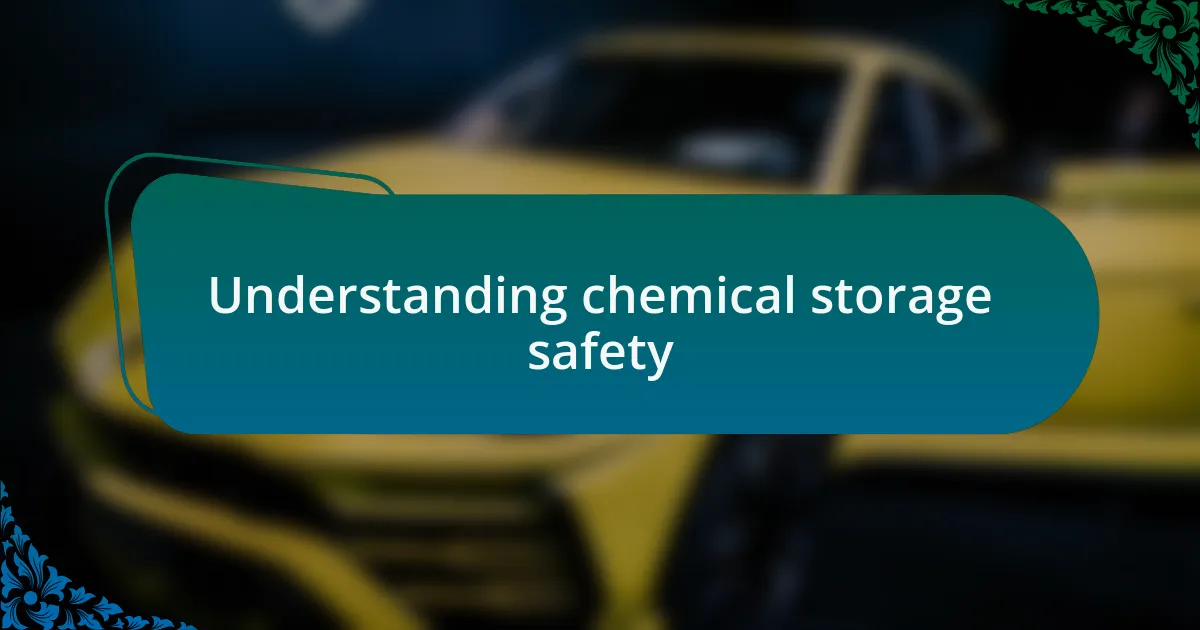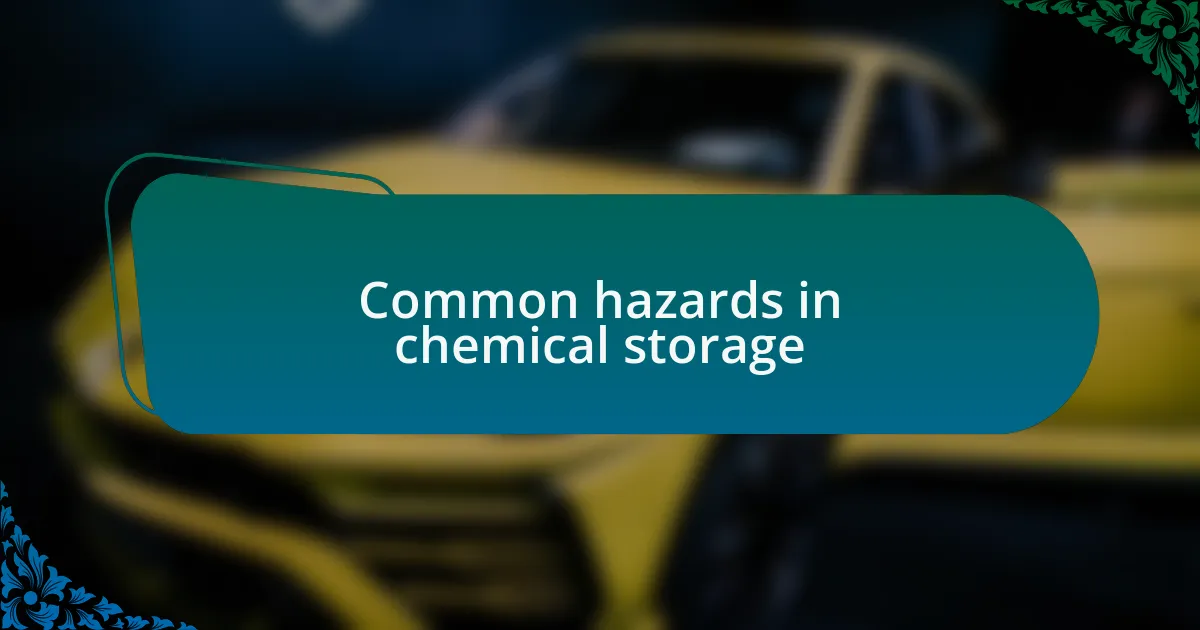Key takeaways:
- Clear labeling and organization of chemicals are essential in preventing accidents and fostering a culture of safety.
- Regular inspections and checks on stored chemicals can help identify hazards and maintain safe environments.
- Training and awareness about chemical compatibility and proper storage practices are crucial to avoid potential disasters.
- Good ventilation is vital for preventing respiratory issues associated with toxic chemical fumes in storage areas.

Understanding chemical storage safety
Chemical storage safety is more than just following guidelines; it’s about cultivating a culture of awareness. I remember a time when a small oversight in organizing cleaning agents led to an unexpected spill. The panic was palpable, and it underscored the importance of understanding how different chemicals can react. Have you ever considered what might happen if incompatible substances were stored together?
In my experience, using clear labels and color-coding can make a huge difference in preventing accidents. I once visited a car wash where they had a simple system in place that made identifying chemicals easy. It felt reassuring to know that everyone, regardless of their experience level, could safely navigate around the storage area.
Having sturdy, well-ventilated storage spaces is essential too. I recall preparing for a safety inspection and transforming a cramped corner into a well-organized chemical storage area, which not only improved safety but also boosted the team’s morale. Don’t you think that creating a safe environment helps everyone feel empowered and responsible?

Importance of safe chemical storage
Safe chemical storage is crucial for preventing accidents and ensuring workplace safety. I once witnessed a near-miss situation at a car wash when a worker accidentally mixed two incompatible cleaners that were stored too closely together. The tension in the air was thick as everyone scrambled to avert disaster, reminding me that every detail in chemical management matters.
Moreover, I can’t emphasize enough how proper storage practices can save not just lives, but also resources. There was a time when I helped reorganize a storage facility, implementing safety protocols and visibility systems. This effort drastically reduced waste and spills, and I could see the team’s confidence grow as they navigated the space with ease. Have you ever felt the relief that comes from knowing you’ve taken action to protect yourself and your colleagues?
Establishing a routine for regular checks on stored chemicals is another key element. During one of these inspections in my previous workplace, we discovered several containers that were nearing their expiration date. The proactive approach not only saved us from potential leaks but also sparked a broader conversation about the importance of staying ahead of safety protocols. Isn’t it fascinating how a simple habit can lead to a culture of safety in the workplace?

Common hazards in chemical storage
When it comes to chemical storage, one of the most prevalent hazards is the threat of leaks or spills. I remember a day when a colleague accidentally knocked over a large container of a corrosive cleaner. The panic in the room was palpable as we scrambled to contain the mess. It was a stark reminder that even an experienced team can face unexpected challenges, urging us to stay vigilant.
Fire risks are another critical concern in any storage area. During my time at a car wash, we had to relocate flammable products when we learned they were stored too close to heating elements. The decision to take immediate action bolstered not just our safety but our morale, reinforcing how crucial it is to maintain proper distances and conditions for volatile substances. Have you ever thought about how just a few adjustments can significantly enhance safety?
Lastly, inadequate ventilation often goes unnoticed but can lead to serious respiratory issues. There was a moment when I found myself in a poorly ventilated storage room, and I nearly stepped back as the chemical odors overwhelmed me. That experience highlighted the necessity of airflow in these spaces. It makes me wonder, how many of us underestimate the importance of good ventilation until we’re reminded in such a striking way?

Best practices for chemical storage
It’s essential to label all chemicals clearly and accurately. I recall the relief I felt when we implemented a more organized labeling system at our facility. It not only made it easier to identify substances quickly, but it also fostered a mindset of accountability among the staff. Have you ever tried finding a specific chemical in a chaotic storage space? It’s nerve-wracking, especially when time is of the essence.
Another best practice is to store chemicals in compatible groups. I distinctly remember a training session where we learned the importance of keeping oxidizers away from flammable materials. One of my colleagues shared a close call involving a mixed-up storage incident that could have been catastrophic. Isn’t it amazing how simple organization can prevent such potentially dangerous situations?
Regular inspections of storage areas are non-negotiable. After experiencing a leak from a poorly sealed container during one of our routine checks, I became a staunch advocate for frequent evaluations. I often find myself questioning, what else could go unnoticed if we don’t take the time to look? A proactive approach can not only save time but also safeguard our well-being in the long run.

Personal experiences with chemical storage
I once struggled through a chaotic chemical storage situation during a particularly busy week. As I rummaged through the disorganized shelves, I felt a knot in my stomach. There’s something unsettling about being surrounded by hazardous materials when you can’t find what you need in a hurry. In that moment, I realized how vital it is to maintain order—not just for efficiency, but for safety.
Another time, I recall a safety drill where we practiced spill containment techniques. The anxiety I felt when the instructor posed a hypothetical scenario about a chemical mixture leak was palpable. What if this had happened in a real situation? Those drills emphasized how crucial it is to know the nature of the chemicals we store, reinforcing my belief that education and awareness can significantly mitigate risks.
One incident that stands out in my mind involved a new employee who neglected to check the compatibility of stored substances. I remember the panic that surged through the team when we uncovered the potential hazard, highlighting the importance of fostering a culture of communication and safety. Have you ever had one of those moments that made you appreciate the power of teamwork in preventing accidents? That experience left a lasting impression on me, driving home the reality that our collective vigilance can safeguard not just ourselves but also everyone around us.